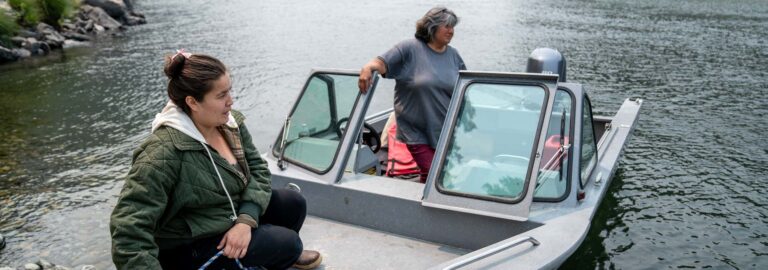Photo: Doreen Ashley (left) and Gloria Mattz (right), fish technicians at the Yurok Fisheries Program, do all they can to help the fish of the Klamath River. Joel Angel Juarez/The Republic
Queen Gensaw skylarked around and between her parents, Oscar and Georgianna, at the Yurok Tribe’s boat ramp at Requa, or Rek-woi, the “mouth of the creek” where the Klamath River meets the Pacific Ocean.
Here, millennia of flowing water infused with sand, silt and the occasional river-smoothed rock has created a cleft about 125 feet deep by nearly 1,000 feet wide. Queen, who is 7, examined shells and danced around the asphalt as her parents talked nearby. For the Yurok fighting to restore the river and secure one of their cultural touchstones — the salmon — Queen and her friends are the future.
Native people were prohibited by law from fishing for subsistence or commercial purposes even after recreational fishing returned.
Requa, on the north side of the Klamath’s massive mouth, is one of California’s longest continually inhabited places. It’s at one end of the Yurok’s 44-mile-long by 2-mile-wide reservation and it was once home to a prosperous fishing industry. Redwood trees and other vegetation tower over homes and a 110-year-old hotel, and at the river’s edge, the Yurok Tribe’s fisheries department sits within the now-tranquil community.
Sea lions cavort in the Klamath’s waters, their growls and barks adding sharp accents to the gentle lapping of the river as it completes its 263-mile journey. The Klamath winds from its headwaters in Upper Klamath Lake through the high desert and grasslands of southern Oregon, between the peaks of the Cascades, eventually creating its own valley as it swells from its meetings with the Salmon, Shasta, Scott and Trinity rivers and numerous creeks and finally kisses the Pacific Ocean.
The south side is part of Redwood National Park, portions of which lie within the tribe’s reservation boundary, and the location of Wehl-kwew, a Brush Dance site that belongs to the family of Yurok General Counsel Amy Cordalis.
Since time immemorial, Yurok people have built plank homes, raised families, harvested salmon, steelhead and surf fish and carefully stewarded their waters and lands along the lower Klamath.
Traders, settlers, lost treaties
The Yurok and other tribes along the Klamath and its watershed had little contact with Europeans, other than a few traders, until California became a U.S. state in 1850.
After the failure of treaties, the U.S. established a reservation for the Yurok along the final 20 miles of the Klamath from Requa in 1855, hoping to keep Indians and settlers apart. The “Klamath River Reservation” was soon joined by the larger Hoopa Reservation in 1864, and the two were joined into one in 1891 when the Yurok’s trust land was extended to the confluence of the Klamath and Trinity rivers.
The Dawes Act, also known as the General Indian Allotment Act of 1887, led non-Indians to claim part of the Yurok’s lands through homesteading. Lumber companies grabbed land as well as farmers, and many Yuroks were forced out of their villages. Some moved to Hoopa, others contrived to stay within their ancestral lands.
Non-Indians took commercial fisheries from Yuroks and established canneries around Requa in the early 20th century. In just a generation, fish numbers plummeted, and, in 1933, the California Department of Fish and Game closed the Lower Klamath to fishing. Native people were prohibited by law from fishing for subsistence or commercial purposes even after recreational fishing returned.
That didn’t stop the Yurok from continuing their millennia-long practices of […]
Full article: www.usatoday.com

